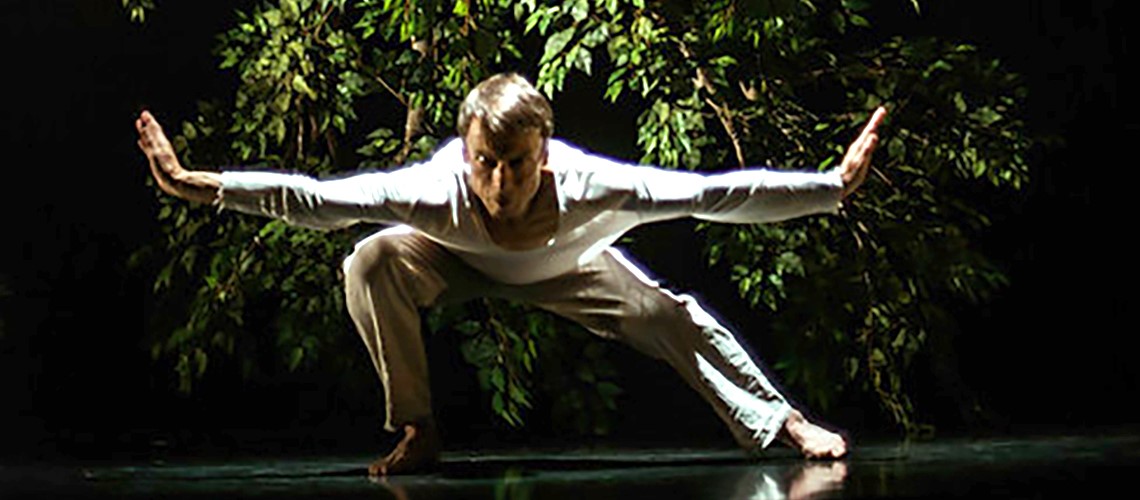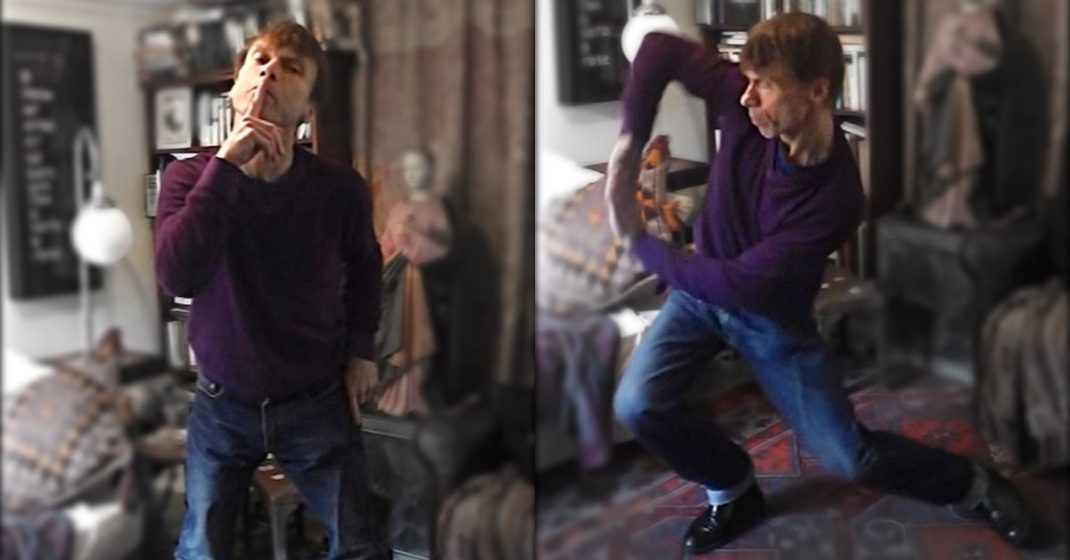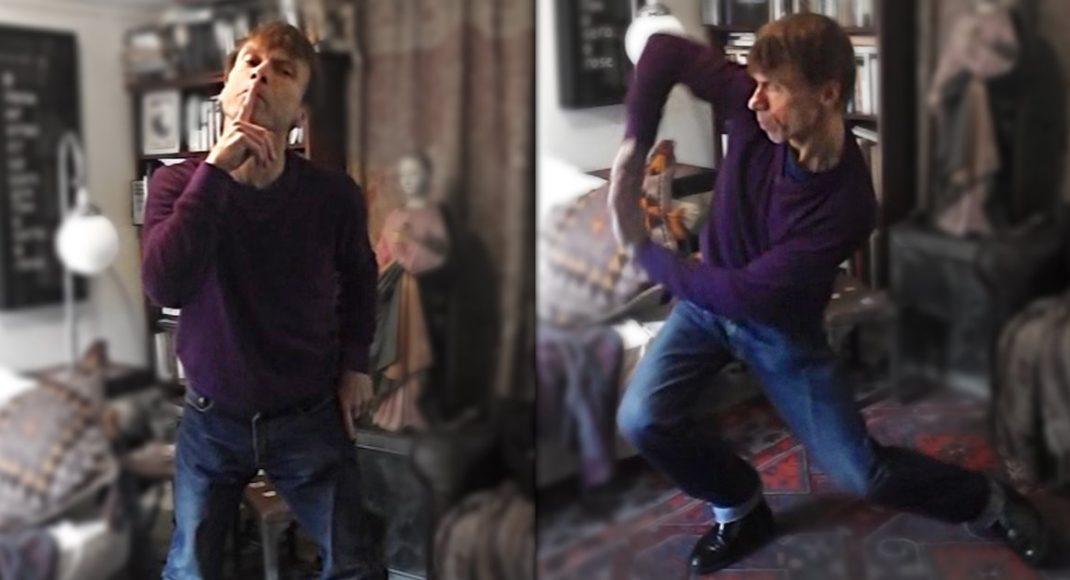15–19 July 2020
Reviewed by Jennifer Shennan
Auld Lang Syne …
Several repeat viewings of this enigmatic little dance have reminded me of auld acquaintance —never to be forgotten, but still very good to have it brought to mind. I see it as Douglas’s conversation with the Vitruvian Man by Leonardo da Vinci. He moves but does not locomote. He stays within his kinesphere.
The first minute is a spoken explanation from Douglas of the work’s gestation—’The images came to me. I told them to go away but they wouldn’t go away, they stayed like a cat scratching its paw on the door to be let in. I found a theme—one we all know about—the search for ecstasy—be that chocolate éclair, heroin rush, or orgasm. That quest is part of everyone’s life. The images grew into the work The Kiss Inside.’
Douglas stands his ground and lets his gestures speak. You can ‘hear’ as his hands sign and pray and plea, let him rest his cheek a little then wake him up. His arms spread like a tree branch, fold like a bird wing, or arc up and over like those of an angel. He signs himself with a cross, touches his fingertip to the pulse points in his throat or face, his breast or groin. He reaches down to walk his hands over the floor in front of him, to check the ground, terra firma, terra incognito. There’s driving pulse in the music by Naftuke Brandwein—Escorting the Bride and Groom Home.
The dance is first shown in Douglas’ home, in his jeans and boots, on the living room carpet, in front of his bookshelf, an art piece on the wall, a statue of a female saint adjacent. The year is 2014. The dance ends with the right arm forward, hand upwards, palm facing us, in a gesture that says ‘Wait’ or ‘Stop’. In Part Two of the film, Douglas dances on stage, within the choreography The Kiss Inside. (Sky City, Auckland, 2015)

A giant tree branch is suspended overhead. Trees exist both above and below ground. Douglas always was a dendrophile, so there are echoes for us of his first choreography for RNZBallet, decades ago, The Decay of Lying—and of the later works, A Far Cry and Forever.
Here Douglas walks on stage, bare foot, dressed in white pyjama. A uniformed nurse, on standby, watches him closely. She’ll be his first responder. His final gesture has re-shaped to become a right arm raised high, with the fist declaring ‘I hereby pledge. This is my truth.’ Douglas then walks to exit stage left.
(Update of 19 July 2020)
*******************************
Douglas Wright, New Zealand’s uniquely meteoric dancer, choreographer, writer, artist, died in late 2018. His last choreography, a short solo, M_Nod, was reviewed in On Dancing. His last full-length work, The Kiss Inside, was also reviewed here.
Douglas’ close colleague, rehearsal director and now choreographic executor, Megan Adams, has produced an unusual and poignant video document which traces the solo Douglas choreographed for himself within The Kiss Inside, but which he was only able to dance at some performances, when his health and stamina permitted.
Tempo Dance Festival, normally an annual live season in Auckland, has become a digital season this year due to Covid restrictions. Megan’s film is being screened this week, until Sunday.
From TDF website: It is an absolute honour to be hosting Douglas Wright’s The Kiss Inside (solo) this week on the Tempo digital stage. Thank you to Megan Adams for bringing this film together and allowing us to share such rare and beautiful footage.
Here’s what Megan has to say about the work:
The Kiss Inside (2015) was the last time Douglas Wright performed on stage. He made an exquisite solo which sadly, due to sickness, he was unable to perform at every venue, so many people missed the opportunity to see him dance. In fact, Douglas didn’t advertise that he was performing, so many people didn’t even know that he had choreographed a solo for himself in this work. This solo was made over many weeks in his lounge in Mount Albert, Auckland. He would make choreographic material and I would visit him every week and he would show me what he had made, tell me where he thought it would go and we’d listened to music he was considering. We would share choreographic ideas and scrutinise every detail of the movement. Afterwards we would drink tea, talk about life and laugh. I occasionally videoed the sessions and the rehearsal footage in the film is of the first time that Douglas performed the entire dance from start to finish. I love the intimacy of the footage, we can hear him breathe and sigh and feel his vulnerability as he finds his way through such an intricate solo for the first time. What an absolute privilege it is to witness visionary artist Douglas Wright rehearsing at home, in his jeans and boots, in front of his favourite chair and the statue of a saint.
Douglas Wright’s The Kiss Inside (solo) will be up on the Tempo website from the 15–19 of July.
There are motifs in this dance we recognise and remember from other work by Douglas (especially Elegy)—a kind of urgent semaphore of gesture, a celestial signing, in which we are being told things. This is before or beyond language—dance typically has no script anyway—but Douglas always had an urgent need to communicate—and indeed used dance, also visual art of found sculpture, and drawing—plus a considerable body of writing, to do just that.
Body of work. Work of the body. How he savoured language and its parallel existence alongside movement to say what he thought we should know.
This ascetic dance catches death by the tail and cheats it by 9 minutes. You can say a lot in 9 minutes if that’s all the time you’ve got. It’s how long it took me to write this review.
Jennifer Shennan, 16 July 2020
Featured image: Douglas Wright rehearsing his solo from The Kiss Inside, 2014.


Jennifer, I recently watched (via the. Baryshnikov Arts Centre site), footage of Opal Loop, a work made by Trisha Brown in 1980. The looseness of the arm movements in her choreography – and they are apparent in a lot of her works throughout the 1980s – reminded me of Douglas Wright’s loose arms in the solo from The Kiss Inside. Douglas was in New York in the early 1980s and, although he worked with Paul Taylor, I’m sure he would have seen a lot of other choreography while there, probably including that by Trisha Brown. I was wondering if you thought there were connections between New York choreography of the 1980s and the loose style that we see from Douglas?
Hello Michelle
I can’t say definitively either way, but my instinct about Douglas’ dance-making is that he was utterly driven by his own imagination and visions, as well as the intense training in gymnastics he had undergone for many years, that these were the resources he drew on for his movement ideas and styles. If Trisha Brown, or anyone else, had been a strong influence on his work I believe he would have said so and discussed what he found of interest in it etc.
He discusses Paul Taylor’s work quite extensively in different places within his writings … and Lloyd Newson’s … but not other choreographers’ ( aside from one hilarious paragraph about Balanchine).